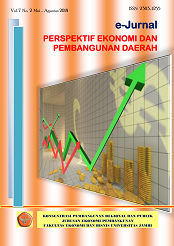Analisis ketimpangan pendapatan pedagang kaki lima di Kota Kuala Tungkal
DOI:
https://doi.org/10.22437/pdpd.v7i2.6890Keywords:
Street vendor, Income inequality, Gini ratioAbstract
This study aims to analyze the socio-economic characteristics and inequality of income of street vendors in Kuala Tungkal City. The data used is sourced from surveys at street vendors. Data were analyzed descriptively and used the gini coefficient and lorentz curve. The results of the study found that street vendors in Kuala Tungkal City were characterized by: 1) Dominated by men with the highest proportion of ages between 26 - 45 years. Merchant education is relatively varied ranging from never going to school to graduating from high school. More than two thirds of them are married with the number of family dependents dominated by 1-4 people. In terms of business location, almost three-quarters of them operate in the market area and only about a quarter of them are trying along the main road. The capital of street vendors in the city of Kuala Tungkal is relatively varied from Rp. 50,000 to over Rp. 1,000,000, with more than half having the same capital or less than Rp. 550,000. Furthermore, in terms of income, most street vendors have an income of Rp. 151,000 - 250,000; 2) Using the method of class three class, the inequality of income of street vendors in the low category with a gini ratio of 0.22772. Furthermore, using the class five class method, the inequality of income of street vendors is also in the low category with a gini ratio of 0.2
Downloads
References
Andhiani, D.K, Erfit, Bhakti, A. (2018). Analisis Pertumbuhan Ekonomi dan Ketimpangan Pembangunan di Wilayah Sumatera. Jurnal Perspektif Ekonomi dan Pembangunan Daerah. 7(1), 26-34
Arsyad, L. (1997). Ekonomi Pembangunan. STIE YKPN: Yogyakarta.
BPS.(2014). Kabupaten Tanjung Jabung Barat dalam Angka:Jambi
Damayanti, I. (2015). Analisis Faktor-faktor yang Mempengaruhi Pendapatan Pedagang Kaki Lima di Pasar Gede Kota Surakarta. .http:/core.ac.uk/download /npdf/12348858.pdf diakses tanggal 13 Mei 2017.
Hidayat. (1978). Peranan Sektor Informal dalam Perekonomian Indonesia†Ekonomi Keuangan Indonesia.XXVI.(4), 415-443.
Junaidi. (2017). Kualitas Sumberdaya Manusia dan Sifat Kewirausahaan Pelaku Industri Kreatif Usaha Mikro Kecil dan Menengah di Kota Jambi. Jurnal Paradigma Ekonomika. 12(2), 101-112
Idris, K., Syaparuddin, Hodijah, S., (2014), Pertumbuhan Ekonomi, Kesempatan Kerja, Kemiskinan dan Ketimpangan Pendapatan di Provinsi Jambi. Jurnal Paradigma Ekonomika. 9(1), 41-62
Nazir, M. (2014). Metode Penelitian. Ghalia Indonesia: Bogor.
Samuelson, P.A & William, D.N. (1996). Mikro Ekonomi, Cetakan Keempat. Erlangga: Jakarta.
Suryana. (2000). Ekonomi Pembangunan: Problematika dan Pendekatan, Salemba Empat: Jakarta.
Todaro,MP. (1994). Economic Development, Edisi Kelima.Longman: London.
Todaro, M.P. (2003). Pembangunan Ekonomi Di Dunia Ketiga, Edisi Keenam. Erlangga: Jakarta.
Downloads
Published
Versions
- 2018-08-22 (1)
- 2018-08-22 (1)





